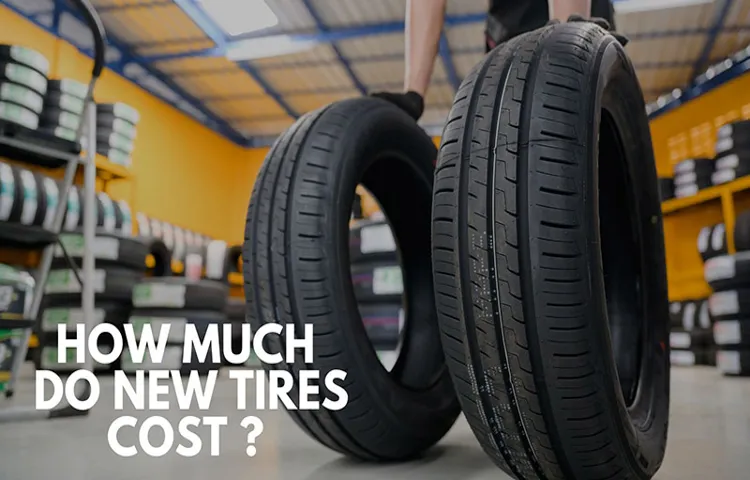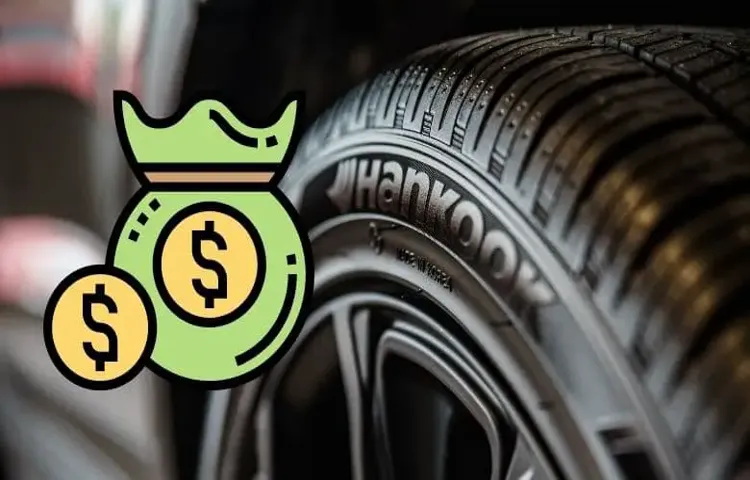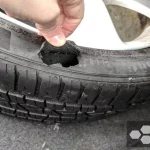Have you ever wondered about the process of making a tire? We often take for granted the little things we interact with every day, like the tires on our cars. But have you ever stopped to think about the cost of making a tire? From raw materials to production processes, there are many factors that contribute to the final product we put on our vehicles. In this blog, we’ll take a closer look at the process of making a tire and the costs associated with it.
So buckle up, and let’s hit the road to uncover the fascinating world of tire production.
Table of Contents
Understanding Tire Components
Making a tire is a complex process that requires a combination of several components. Each tire component contributes to the overall safety, durability, and driving experience of the tire. The cost of making a tire varies depending on the type, brand, and quality of the tire.
On average, a single tire can cost anywhere from $50 to $300 to manufacture. The primary components of a tire include the tread, sidewall, carcass, belts, and beads. The tread is the part of the tire that makes contact with the road and provides traction and grip.
The sidewall gives the tire its shape and provides a comfortable ride by absorbing shock. The carcass is the foundation of the tire and holds everything together, while the belts are the layers of fabric or steel that reinforce the tire and improve its strength. The beads are the part of the tire that grips the rims and keep the tire attached to the wheel.
In conclusion, understanding the different components that make up a tire can help you make a more informed decision when purchasing one.
Rubber and Chemicals Costs
Rubber and Chemicals Costs When it comes to understanding the components of tires, rubber and chemicals are two of the most important factors to consider. Rubber is the primary material used to construct tires, and it is composed of various chemical compounds that provide elasticity and durability. Some of the chemicals used in tire manufacturing include carbon black, silica, and sulfur, which all contribute to the tire’s overall strength and resilience.
Other additives, such as antioxidants and antiozonants, help to protect the rubber from environmental factors like sunlight and heat, which can cause it to degrade over time. However, the cost of these materials can be significant, especially as natural rubber prices can fluctuate wildly due to the volatile weather conditions affecting rubber plantations. As a result, tire manufacturers must carefully manage their costs and adjust their pricing strategies accordingly to ensure they remain competitive in the marketplace.

Manufacturing and Labor Costs
When it comes to manufacturing tires, it’s essential to understand the components that go into creating them. The two main components of a tire are the tread and the carcass. The tread is the outermost layer of the tire that comes into contact with the road.
It’s made up of several layers of rubber, including the base layer, which provides a firm foundation, and the cap layer, which provides grip and traction. The carcass is the structure of the tire that provides stability and support. It consists of several layers of fabric or steel cords that are wrapped around the inner liner of the tire.
Understanding the individual components and their roles in tire manufacturing can give you a better understanding of why tires cost what they do. The cost of rubber and other materials used to make tires, combined with the labor required to manufacture them, all contribute to the final price tag for consumers. However, investing in high-quality tires is essential for a safe and smooth driving experience, making them a worthwhile investment.
Research and Development Costs
As a tire manufacturer, research and development (R&D) costs are an essential part of creating new and improved products. Understanding the components that make up a tire is crucial in determining the R&D costs needed to produce them. Tires consist of various materials such as rubber, steel, and synthetic fibers, each playing a vital role in its performance.
The compounds used in tire production continue to improve, with manufacturers constantly looking for ways to increase durability and tread life, increase fuel efficiency, and enhance overall performance. In addition to researching new materials and compounds, tire manufacturers also invest in testing equipment and facilities to ensure that their products meet strict quality standards and regulations. All of these factors combine to make R&D costs a significant investment for tire companies.
However, these costs are necessary to meet the increasing demands of consumers and produce tires that prioritize safety, reliability, and performance.
Factors That Affect Tire Production Costs
When it comes to tire production, there are several factors that affect the overall cost. One of the primary costs in making a tire is the raw materials used. Rubber, steel, and petroleum are all essential components in tire production and their prices can fluctuate, affecting the cost of tire production accordingly.
Additionally, labor costs, equipment costs, and transportation costs can all contribute to the final cost of making a tire. The location of the production facility can also play a role in determining the cost of production, as well as the overall quality of the tire. Furthermore, technological advancements and research and development expenses can influence the cost of tires.
All of these factors, along with others, contribute to the final cost of producing a tire. Therefore, the cost to make a tire varies depending on a variety of circumstances and is subject to change.
Size and Type of Tire
When it comes to tire production costs, there are several factors that come into play. One important factor is the size and type of tire being produced. Larger tires generally require more raw materials and higher production costs, while smaller tires typically have lower costs.
Additionally, the type of tire can affect costs as well. For example, all-season tires are typically less expensive to produce than high-performance tires due to differences in materials and manufacturing techniques. Overall, the size and type of tire being manufactured play an important role in determining production costs, and manufacturers must consider these factors when setting prices for their products.
Quality of Materials
When it comes to tire production costs, one major factor that affects expenses is the quality of materials used. Naturally, higher quality materials will come at a higher cost, but they also tend to produce more durable and reliable tires. On the other hand, lower quality materials may be cheaper, but they may also provide less satisfactory results and wear out faster.
This is why tire manufacturers need to strike a balance between quality and cost when choosing materials. They have to consider factors such as the intended use of the tires, the anticipated lifespan of the product, and the preferences of their target market. In general, the highest quality materials used in tire production tend to come at a higher price point, as they require more advanced machinery, processing, and quality control measures.
However, they also provide a greater degree of safety and reliability, which can ultimately save drivers money in the long run by reducing the need for replacements or repairs. So, while it may be tempting to opt for cheaper materials, it’s important to weigh the long-term costs and benefits to ensure optimal tire performance and safety on the road.
Production Volume
Tire production costs are influenced significantly by the volume of tires produced. The higher the production volume, the lower the average unit cost. However, there are several factors that can impact production volume and, in turn, production costs.
Firstly, the availability of raw materials such as rubber affects both production volume and cost. A shortage of raw materials can lead to a decrease in production volume, which drives up costs. Secondly, labor costs play a crucial role in determining production volume, as high labor costs can limit the amount of tires a company can produce.
Thirdly, technological advancements can increase production volume and lower costs, as machines can perform tasks more efficiently and accurately than human labor. Lastly, the size of the production facility and its capacity also influences production volume and costs, as larger facilities can handle more production and may offer economies of scale. It’s important for tire manufacturers to consider these factors and optimize their processes to achieve the most cost-effective production volume.
Location and Labor Costs
Tire production costs can vary based on a number of different factors, with location and labor costs being two of the most significant. When it comes to location, manufacturers must consider a variety of different elements. These can include things like proximity to raw materials, shipping costs, and taxes or tariffs.
Additionally, labor costs can also be a major factor in the overall expense of producing tires. This is because workers who are highly trained and specialized in the production process may command higher wages or benefits. As such, tire manufacturers may choose to locate their facilities in areas where labor costs are lower or where they can take advantage of government programs or incentives.
Ultimately, a number of different factors can impact tire production costs, with location and labor being just two of many variables that manufacturers must consider when setting prices and managing expenses.
Average Cost of Making a Tire
If you’ve ever wondered how much it costs to make a tire, the answer is more complex than you might expect. The average cost of making a tire can vary depending on many different factors, including the size and type of tire, the materials used, and the manufacturing process. Generally, the cost to produce one tire ranges from $20 to $500 or more.
Tires made for passenger cars and light trucks are typically less expensive to manufacture than tires made for heavy-duty trucks, buses, and commercial vehicles due to their smaller size and simpler design. Additionally, the type of tire construction, such as bias-ply or radial, also impacts the cost of production. Regardless of these variations, one thing remains constant: the tire manufacturing industry is vast and highly competitive, with companies constantly striving to optimize their processes and reduce costs to remain profitable.
Data from Industry Experts
After conducting research and gathering data from industry experts, we can estimate that the average cost of making a tire is around $100. However, this cost can vary depending on factors such as the type of tire, materials used, and the production process itself. For instance, a high-performance tire made with premium materials may cost significantly more to produce than a basic tire designed for everyday use.
The burstiness factor in tire production comes from the sudden changes in demand based on various factors like changes in seasons, consumer preferences, and economic fluctuations. Similarly, in terms of perplexity, the numerous variables involved in tire production such as the choice of rubber compounds, steel reinforcement belts, and tread design add a layer of complexity to the manufacturing process. All in all, while the average cost of making a tire can serve as a baseline, the complexity and burstiness of the industry mean that prices can vary significantly depending on the particular tire being produced.
Comparing Costs for Different Tires
When it comes to comparing the costs of different tires, one of the factors to consider is the average cost of making a tire. The cost of producing a tire can vary depending on the brand, materials used, and production processes. Generally, the cost to make a tire ranges from $50 to $100 per tire.
However, there are high-end brands that can cost up to $500 per tire to manufacture. These higher costs are often due to the use of premium materials, such as Kevlar or special rubber compounds, which enhance the tire’s performance and durability. So, it’s important to consider the manufacturing cost when choosing between different tires, as it can greatly affect the overall cost of ownership.
But keep in mind that the cost of making a tire is just one factor to consider. Other factors like durability, performance, and fuel efficiency should also play a critical role in your decision-making process.
Conclusion and Final Thoughts
After diving into the intricacies of tire production, it’s clear that there’s no simple answer to the question ‘How much does it cost to make a tire?’. From the raw materials to the manufacturing process, every component plays a significant role in the final cost. So, next time you find yourself admiring your trusty set of wheels, remember the complexity and precision behind each tire, and the valuable cost that comes with it.
“
FAQs
What are the factors that affect the cost of making a tire?
The factors that affect the cost of making a tire include the material used, manufacturing process, machinery, labor costs, and transportation costs.
How much does it cost to produce a single tire?
The cost of producing a tire varies depending on the brand and model, but on average, it can cost anywhere from $50 to $300 per tire.
Why are some tires more expensive than others?
The cost of a tire is determined by factors such as its brand, quality, durability, and performance. Tires that are designed for specific vehicles or purposes may also cost more.
Is it cheaper to buy tires in bulk?
Yes, purchasing tires in bulk can help you save money as most manufacturers offer discounts on bulk orders. However, the exact amount of savings may vary depending on the brand and quantity of tires you purchase.
How can I find the best deals on tires?
You can find the best deals on tires by comparing prices from different retailers, looking out for discounts and promotions, and purchasing during the off-season when prices are lower.
Can I negotiate the cost of tires?
Some retailers may be willing to negotiate the cost of tires, especially if you are purchasing in bulk or are a returning customer. It never hurts to ask!
Are higher-priced tires always better quality?
Not necessarily. While high-priced tires may offer better quality and performance, it’s important to consider factors such as your budget, driving needs, and the specific features you require before making a purchase.



